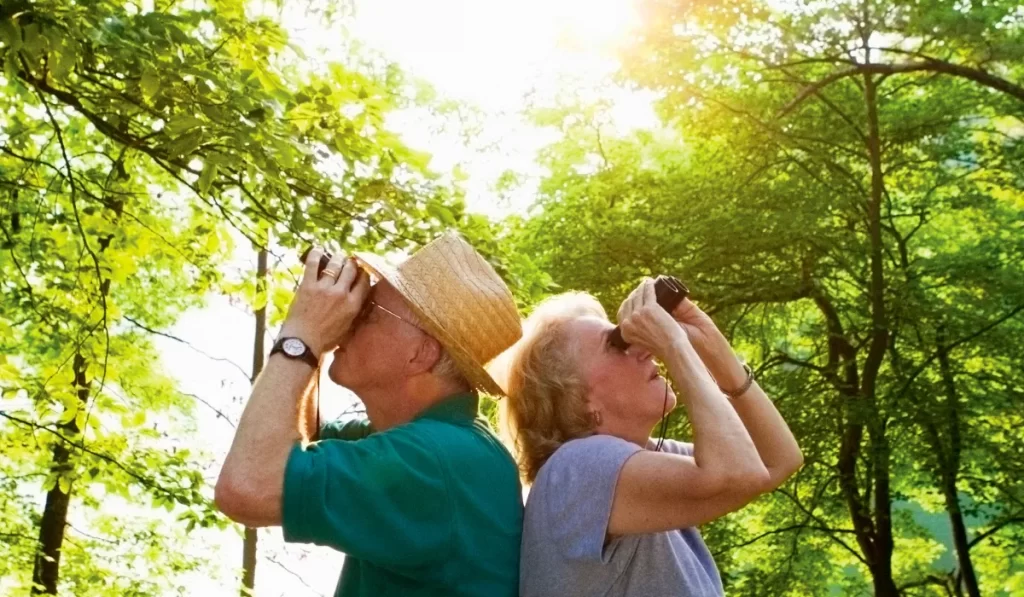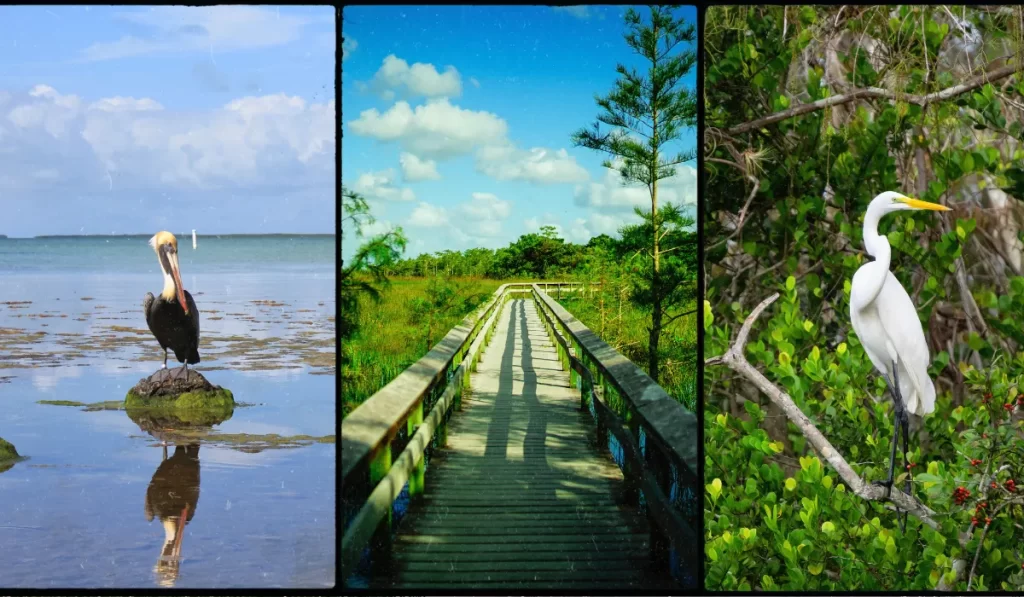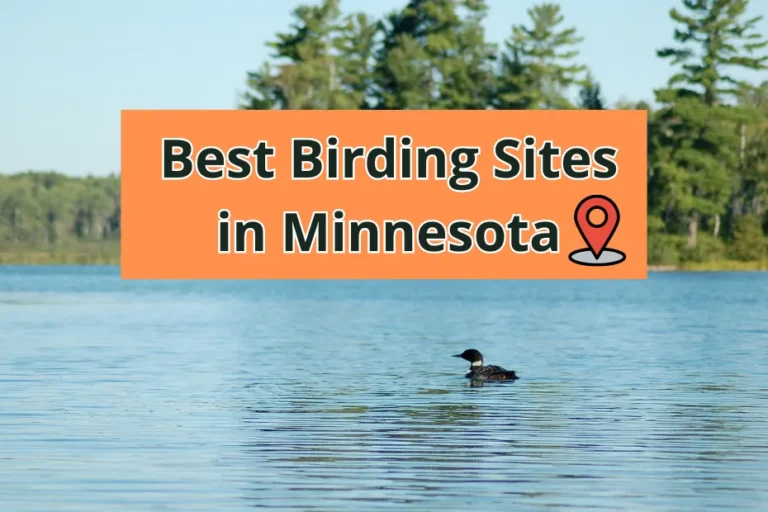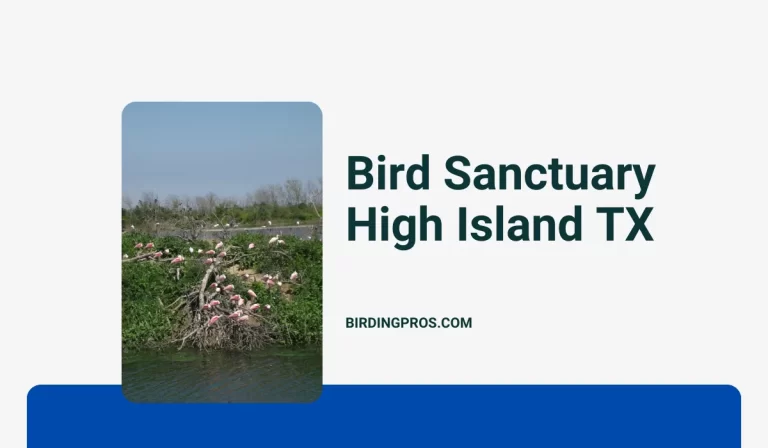Bird Watching Hotspots In The USA
Discover the top birdwatching hotspots in the USA, where diverse landscapes and rich avian life create a birder’s paradise. From the vibrant Rio Grande Valley in Texas to the serene Cape May in New Jersey, each location offers unique birding experiences
Table of Contents
Why Birdwatching in the USA?

In the USA, birdwatchers are spoiled for choice, as the country boasts diverse landscapes and a wide variety of bird species. Whether you’re a seasoned birder or a beginner, exploring these hotspots can be a rewarding experience.
The USA’s geographical diversity plays a significant role in attracting birdwatchers. From coastlines to mountains, deserts to wetlands, each region offers unique habitats.
Birdwatching provides relaxation, stress relief, and a chance to contribute to citizen science efforts through platforms like eBird.
Top Bird Hotspots in the USA
Let’s embark on a journey to explore some of the top bird hotspots across the United States. From coast to coast, these destinations offer unparalleled opportunities to observe and appreciate the rich diversity of avian life.
Cape May, New Jersey: A Migration Marvel

Cape May, New Jersey, is a renowned birdwatching paradise, especially during migration seasons. Here’s how you can enjoy birdwatching in this area:
- Visit the Cape May Bird Observatory: Founded in 1976, the observatory is a hub for research, education, and conservation. It’s the perfect starting point for any birdwatching adventure.
- Explore Popular Trails: Trails like the Higbee Beach Loop Trail and South Cape May Meadows offer excellent birdwatching opportunities with a variety of habitats.
- Join Guided Tours: New Jersey Audubon offers weekly tours led by knowledgeable naturalists at top spots like Higbee Beach, Cape May Point State Park, and the back bay areas.
- Participate in Events: Engage in events like the World Series of Birding or special field trips organized by the observatory to deepen your birding experience.
- Utilize Observation Points: The Cape May Marsh Boardwalk leads to an observation blind where you can comfortably watch birds and learn from posted information.
Remember to bring your binoculars, a field guide, and a sense of adventure as you explore the diverse birdlife that Cape May has to offer.
Point Pelee, Ontario: A Crucial Stopover
Point Pelee, Ontario, is a critical stopover for birds during their migratory journeys, making it a premier destination for birdwatchers. Here’s how to make the most of your visit:
- Time Your Visit: The peak of bird migration occurs in May during the Festival of Birds, but the park offers bird diversity year-round.
- Explore the Trails: Trails like the Marsh Boardwalk and Centennial Bicycle Trail provide varied habitats for birdwatching.
- Attend Workshops: Winter Waterfowl Workshops offer a chance to see over 30 species of waterfowl present through the colder season.
- Use Birding Resources: Tools like eBird and iNaturalist can enhance your birding experience by helping you track and share sightings.
- Follow Ethics: Respect the birds and their habitats by adhering to the birding and photography ethics provided by the park.
With over 390 species recorded, Point Pelee’s unique location on major migratory flyways and the north shore of Lake Erie makes it an exceptional birding spot. Enjoy your birdwatching adventure at this crucial stopover!
Everglades National Park, Florida: Wetland Wonderland

Everglades National Park in Florida is a true wetland wonderland, offering a unique birdwatching experience with over 300 bird species. Here’s how to enjoy birdwatching in this lush landscape:
- Choose the Right Season: The best birding season is from December to March, during the winter dry season, when birds congregate around permanent water bodies.
- Visit Key Spots: Explore trails like the Anhinga Trail, Mahogany Hammock, and Paurotis Pond for diverse bird sightings.
- Take Guided Tours: Shark Valley offers tram tours providing close encounters with the park’s birdlife.
- Attend Birding Events: Participate in birding festivals and events for guided walks and educational talks
- Respect the Environment: Always follow park rules and birding ethics to protect the wildlife and habitats you’re enjoying
With its vast marshes, dense mangroves, and open waters, the Everglades is a haven for birdwatchers and nature lovers alike. Don’t forget your binoculars and camera to capture the beauty of this unique ecosystem!
Monterey Bay, California: Coastal Charms
Monterey Bay, California, is a coastal charm for birdwatching enthusiasts, offering a stunning array of habitats and a rich diversity of bird species. Here’s how to enjoy birdwatching in this beautiful region:
- Visit the Elkhorn Slough Estuary: Recognized as one of the prime birding areas, the estuary provides sanctuary to over 340 bird species, including shorebirds, waterfowl, and raptors
- Explore the Carmel River Mouth: A historic birding site since the early 20th century, it’s home to species like terns, gulls, curlews, and sandpipers
- Take a Pelagic Birding Tour: Monterey Bay’s deep submarine canyon and nutrient-rich waters attract an abundance of seabirds. Join a boat tour from Fisherman’s Wharf for a chance to see pelagic species
- Enjoy the Birding Trails: Trails such as Garland Ranch Regional Park offer diverse birdwatching opportunities, from oak woodlands to chaparral habitats
- Engage with the Monterey Audubon Society: Participate in field trips and events organized by the society to explore various areas in Monterey County and spot a wide range of birds, including the California condor
With its protected habitats and a total of 489 bird species recorded in the county, Monterey Bay is a must-visit for birders from around the world.
Don’t forget your binoculars and a good field guide like ‘Monterey Birds’ by Don Roberson to enhance your birdwatching experience. Happy birding!
Bosque del Apache National Wildlife Refuge, New Mexico: Winter Wonderland
Bosque del Apache National Wildlife Refuge in New Mexico transforms into a winter wonderland for birdwatchers, especially known for its spectacular gatherings of sandhill cranes and snow geese.
Here’s how to experience birdwatching in this enchanting refuge:
- Time Your Visit: Winter, particularly from November to January, is the best time to visit when thousands of birds make the refuge their home
- Attend the Festival of the Cranes: Held annually in November, this festival celebrates the return of the cranes with tours, workshops, and events
- Explore the Trails: The refuge offers a variety of trails and loops that provide access to different habitats and excellent birdwatching opportunities
- Use Observation Blinds: These are strategically placed for optimal bird viewing without disturbing the wildlife
- Volunteer: Engage more deeply with the refuge by participating in volunteer programs, which can offer unique insights and experiences
With its stunning landscapes and abundant birdlife, Bosque del Apache is a must-visit for any bird enthusiast looking to witness the majesty of avian migration in a serene setting.
Great Smoky Mountains National Park, Tennessee/North Carolina: Mountain Majesty
Great Smoky Mountains National Park, straddling the border between Tennessee and North Carolina, is a majestic mountain haven for birdwatchers. Here’s how to enjoy birdwatching in this national treasure:
- Visit Notable Birding Areas: Cades Cove offers open habitats for easier bird viewing, while the Sugarlands Visitor Center provides a mix of open habitat with forest edge, ideal for spotting Northern Parulas and Pileated Woodpeckers
- Time Your Visit: Warblers are most diverse during the breeding season, and you can see species like the Chestnut-Sided and Blackburnian Warblers. Winter brings the chance to spot rarities like the Long-eared Owl
- Explore the Trails: The park has several trails perfect for birdwatching, such as the Gatlinburg Trail and the Balsam Mountain Loop, offering opportunities to see a variety of bird species in different habitats
- Utilize Birding Apps: Download bird identification apps like the Cornell Lab of Ornithology’s free app before your trip to help with bird identification and to learn common bird songs
- Practice Responsible Birding: Avoid using recorded calls or spotlighting, as this can disturb the birds. Instead, enjoy their natural behavior and contribute to conservation by planting native, bird-friendly plants at home
With over 240 species documented, including 60 year-round residents and nearly 120 breeding species, the Great Smoky Mountains National Park is a birdwatching destination that promises both beauty and diversity. Remember to bring your binoculars and enjoy the symphony of birds in this iconic wilderness.
Texas Gulf Coast: Coastal Gem
The Texas Gulf Coast is a coastal gem for birdwatching enthusiasts, offering a diverse array of habitats that attract a wide variety of bird species. Here’s how you can enjoy birdwatching along this vibrant coastline:
- Visit the Gulf Coast Bird Observatory: This independent non-profit organization is dedicated to protecting birds and their habitats around the Gulf of Mexico and beyond. It’s a great place to start your birdwatching journey
- Explore Birding Hotspots: The Texas Gulf Coast is home to numerous birding hotspots, including Anahuac National Wildlife Refuge and Aransas National Wildlife Refuge, where you can see a plethora of bird species
- Attend Birding Events: Keep an eye out for birding festivals and events that offer guided walks, workshops, and the opportunity to meet fellow birders
- Utilize Birding Apps: Apps like Sibley Birds 2nd Edition and Merlin can enhance your birdwatching experience by helping you identify birds and record birdsongs
- Respect Wildlife and Habitats: Always follow ethical birdwatching practices to ensure the protection of birds and their natural environments
With its rich avian life and beautiful coastal scenery, the Texas Gulf Coast is a must-visit destination for birdwatchers looking to add to their life lists or simply enjoy the beauty of nature.
Alaska: Wild Beauty
Alaska, with its wild beauty, is a birdwatcher’s dream. Here’s how to immerse yourself in birdwatching in this majestic land:
- Visit Top Birding Hotspots: Explore renowned locations like the Copper River Delta, where millions of shorebirds gather, or the Pribilof Islands, home to vast colonies of seabirds
- Time Your Adventures: The best birdwatching is often at low tide and during early morning or late evening when birds are most active
- Embrace the Seasons: Each season offers a different spectacle, from the spring migration frenzy to the summer nesting and the fall departure
- Join Local Festivals: Participate in events like the Kachemak Bay Shorebird Festival, which celebrates the return of migratory birds with guided walks and educational programs
- Follow Ethical Practices: Respect the wildlife by keeping a safe distance and using binoculars or scopes to minimize disturbance
With over 400 avian species, Alaska’s pristine landscapes provide an unparalleled birdwatching experience. Don’t forget to bring your sense of wonder and adventure to this birding paradise!
Arizona: Habitat Variety
Arizona’s diverse habitats make it a fantastic destination for birdwatching. Here’s how to enjoy the variety of bird habitats Arizona offers:
- Explore Canyons and Mountains: Visit Madera Canyon in the Santa Rita Mountains, the Chiricahua Mountains, and the Huachuca Mountains for a chance to see species like the Elegant Trogon and the Magnificent Hummingbird
- Discover Riparian Areas: Riparian preserves, such as the ones at Water Ranch or along the San Pedro River, offer lush environments where you can spot waterfowl and other birds that thrive near water
- Drive the Scenic Routes: The Catalina Highway up to Mount Lemmon provides stunning views and birdwatching opportunities, especially for mountain species
- Visit Wetlands: Places like Sweetwater Wetlands are excellent for observing water birds and are easily accessible for all levels of birdwatchers
- Attend Bird Festivals: Keep an eye out for bird festivals and events that celebrate Arizona’s bird diversity and offer guided tours and workshops
With these tips, you’re set to experience the best birdwatching Arizona has to offer, from its deserts to its sky islands.
Hawk Mountain Sanctuary, Pennsylvania: Raptor Haven
Hawk Mountain Sanctuary in Pennsylvania is a raptor haven, celebrated as the world’s first refuge for birds of prey. Here’s how to enjoy birdwatching at this sanctuary:
- Participate in the Hawk Watch: Join the Hawk Watch program to observe the annual migration of raptors, including hawks, eagles, and falcons
- Visit During Peak Migration: The best time to visit is between August and December, when an average of 18,000 raptors fly past the sanctuary’s ridgetops
- Engage in Educational Programs: Hawk Mountain offers a variety of educational programs, both on-site and through distance learning, to learn about raptor conservation
- Explore the Trails: Hike the sanctuary’s trails for breathtaking vistas and the chance to spot various species of birds of prey
- Attend Special Events: Look out for close-up encounters with birds and talks by wildlife experts, especially on weekends
With its commitment to raptor conservation and education, Hawk Mountain Sanctuary provides a unique opportunity to witness these majestic birds in their natural habitat. Remember to bring your binoculars and a sense of wonder to this extraordinary birdwatching destination.
Yellowstone National Park, Wyoming, Montana, Idaho: Iconic Wilderness
Yellowstone National Park, straddling Wyoming, Montana, and Idaho is an iconic wilderness that offers birdwatchers a chance to see nearly 300 bird species in a variety of natural settings. Here’s how to embark on a birdwatching adventure in Yellowstone:
- Visit Key Locations: The Lamar Valley, Madison River, and Yellowstone Lake are prime spots for observing a range of birds, including raptors, songbirds, and waterfowl
- Time Your Visit: Spring and early summer are great times to see many birds, including the park’s famous trumpeter swans
- Join Guided Tours: Consider taking a wildlife safari or guided tour to learn from experienced guides and enhance your birdwatching experience
- Attend Birding Events: Look out for birding festivals and events that offer educational programs and the opportunity to connect with fellow bird enthusiasts
- Practice Ethical Birdwatching: Always view birds from a distance to avoid disturbing them, and follow the park’s guidelines for wildlife observation
With its vast landscapes and abundant wildlife, Yellowstone National Park is a birdwatcher’s paradise waiting to be explored. Remember to bring your binoculars and a field guide to make the most of your visit to this majestic land.
Within the Greater Yellowstone Ecosystem, Yellowstone National Park is home to a diverse array of bird species. Explore this iconic wilderness and discover the avian wonders that call it home.
Tips for Birdwatchers
Gear You Should Take
Bring binoculars, a field guide, and comfortable clothing. Good optics enhance your birdwatching experience belive me.
Respect Wildlife
Keep a safe distance from birds and their nests. Avoid disturbing their natural behavior. They can expect it right?
Join Local Clubs
Connect with local birdwatching clubs or participate in guided tours to learn from experienced birders.
FAQs About Bird Watching Hotspots
1. What is the best time of year to visit Hawk Mountain Sanctuary for raptor watching?
The best time to visit Hawk Mountain Sanctuary for raptor watching is during the peak migration season, which runs from August to December. The sanctuary hosts the annual Hawk Watch program during this period, offering visitors the chance to observe thousands of raptors in flight.
2. Can I participate in birdwatching events at Point Pelee, Ontario, outside of the Festival of Birds in May?
Yes, Point Pelee National Park offers birdwatching opportunities year-round, and while the Festival of Birds in May is a highlight, the park also hosts other events such as the Winter Waterfowl Workshops, which allow visitors to see a variety of waterfowl species during the colder months.
3. Are there any guided tours available in Everglades National Park for birdwatching?
Everglades National Park offers a range of guided tours, including tram tours at Shark Valley, which provide close encounters with the park’s diverse birdlife. These tours are led by knowledgeable guides who can enhance your birdwatching experience.
4. What kind of birds can I expect to see at Bosque del Apache National Wildlife Refuge in New Mexico?
Bosque del Apache National Wildlife Refuge is famous for its large flocks of sandhill cranes and snow geese that visit during the winter months. In addition to these, visitors can also see a variety of ducks, raptors, and other migratory birds that stop at the refuge.
Conclusion
Birdwatching hotspots in the USA offer a gateway to the avian world. Whether you’re a casual observer or a dedicated birder, these locations provide a chance to marvel at the intricate lives of birds.
So, grab your binoculars, explore these hotspots, and let the wings of curiosity take flight!
Stay With BirdingPros for more birding tips.
Reference:
https://www.fws.gov/refuge/bosque-del-apache
https://www.adfg.alaska.gov/index.cfm?adfg=birdviewing.hotspots






